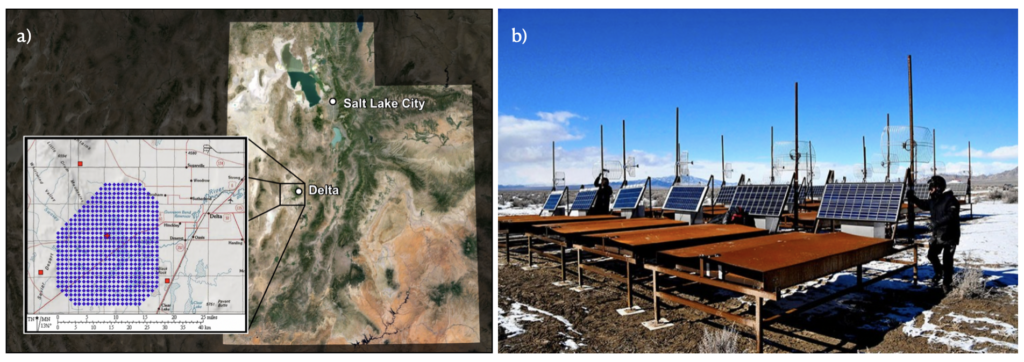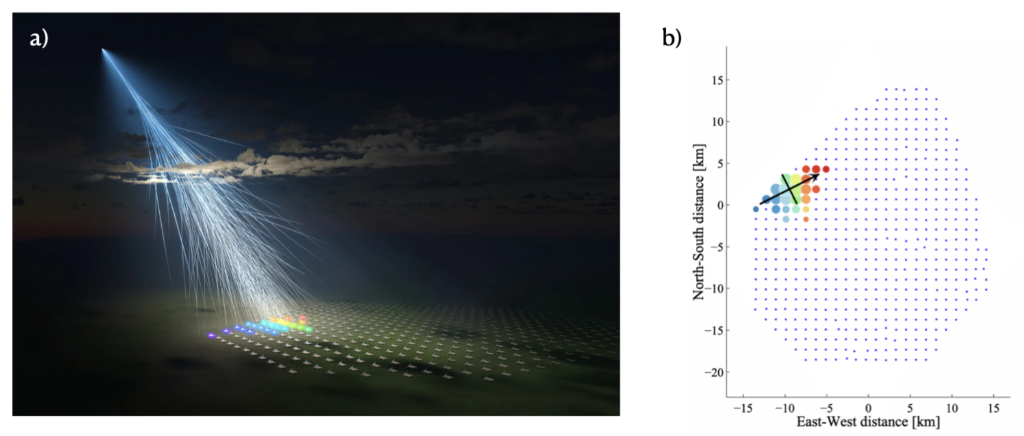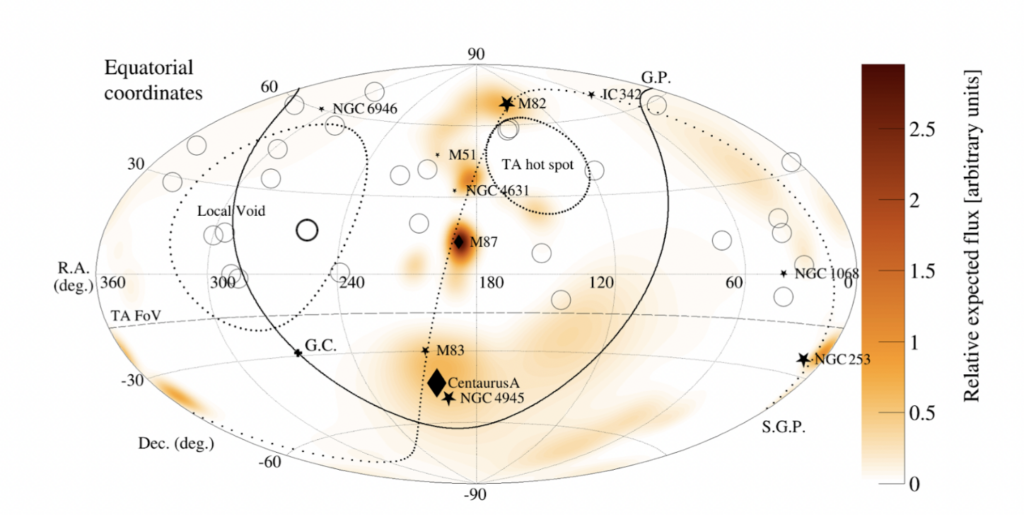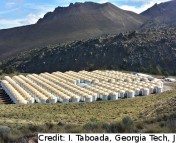Title: An extremely energetic cosmic ray observed by a surface detector array
Authors: Telescope Array Collaboration
First Author’s Institution: Hakubi Center for Advanced Research and Graduate School of Science, Kyoto University, Sakyo, Kyoto, 606-8502, Japan
Status: Published in Science [closed access]
Cosmic rays: where do they come from? Where do they go?
Cosmic rays are energetic, charged particles (protons or nuclei) that zoom through space at speeds very close to the speed of light. However, it turns out that we don’t know exactly where in space they’re coming from. Because they’re charged, cosmic rays get shot off in all directions by the Milky Way’s magnetic field as well as any other magnetic fields they may encounter on their way to Earth.
We see cosmic rays in our detectors on Earth at all sorts of energies, from GeV to above EeV energies, with the flux (amount per area per time) of cosmic rays dropping off rapidly with energy. This means that cosmic rays at EeV energies (about a million times the energy of the particles accelerated in particle accelerators like the LHC) are extremely rare.

b) A close-up of a few of the scintillation detectors. From the Nature press release.
A goddess of a particle
Today’s authors manage to catch one of these elusive EeV cosmic rays using the Telescope Array (TA) in Utah, an huge (300 square miles) array of detectors, designed to catch the highest energy cosmic rays (see Figure 1).
While combing through old data, the authors were surprised to find the highest energy cosmic ray that TA had ever seen, at 240 EeV, named Amaterasu after a sun goddess in Japanese mythology. To put Amaterasu’s energy into a more down-to-Earth context, this is about the energy of a baseball thrown by a professional pitcher. Amaterasu is among the three highest energy particle ever observed, one of which is the Oh-My-God particle, which was discovered in 1991 at 320 EeV. The “Oh-My-God” nickname originated because it was previously thought impossible that particles could reach such high energies.

b) The measured particle interactions (called events) from Amaterasu in the TA detectors. Colour represents the timing of each event, with bluer events happening earlier than redder events (the arrow represents the time evolution). The size of each circle represents the particle density in each detector. Figure 1 from the paper.
Cosmic rays collide with the atmosphere and interact with atmospheric particles to make secondary particles, that interact to make more particles, etc., to make showers of particles that eventually hit TA detectors, where their kinetic energy is converted into light in a process called scintillation. The amount of light (which is essentially an energy proxy) produced by these particles is measured by each detector and a map of the particle shower hitting the array can be made (see Figure 2).
Making a cosmic ray treasure map
Although a few EeV cosmic rays have been detected over the years, there’s so much we don’t understand about them. Using the bits of information they know about Amaterasu, today’s authors try to put together these clues to understand the bigger picture of how and where cosmic rays are made. These clues include Amaterasu’s energy, direction, and the fact that it is very likely a charged particle and not a photon.
Because of Amaterasu’s super high energy, the authors are pretty sure that it comes from pretty close by (astronomically speaking, of course!). This is because there’s a cutoff (called the Greisen–Zatsepin–Kuzmin (GZK) limit), which is a way of quantifying the probability that a cosmic ray collides with a cosmic microwave background (CMB) photon on its way to Earth, which naturally will increase with distance. In this collision, the cosmic ray loses a lot of energy, so EeV scale cosmic rays become impossible beyond distances of 50 megaparsecs (or ~160 million light years).
They’re also pretty sure they know where Amaterasu comes from! Although most cosmic rays are shot off in all sorts of directions by magnetic fields, Amaterasu has so much kinetic energy that any magnetic forces are somewhat negligible in changing its route and the authors are able to trace it back directly to its source of origin (see Figure 3).

Out of the void, into the inferno
The only issue is that Amaterasu doesn’t seem to come from anywhere. In our local universe, matter seems to be rather clumpy, so there’s regions with a lot of galaxies and there’s regions without a lot of anything, called voids. Amaterasu can be traced back to our Local Void, where there aren’t a lot of things to make and accelerate particles (cosmic rays are thought to be produced in systems like active galactic nuclei; AGNs, or starburst galaxies).
There aren’t any good candidate galaxies at the distance and position of Amaterasu though, which can mean one of two things: either Amaterasu is coming from a galaxy located further away than the GZK limit, meaning that maybe Amaterasu comes from a new type of particle that’s immune to the GZK limit or another scenario that challenges particle physics as we understand it. The second scenario is somewhat less fun but slightly more plausible: maybe Amaterasu was deflected more than the authors thought, which might mean it came from close to the Galactic plane of the Milky Way, where magnetic fields are stronger.
The cosmic ray puzzle continues…
Regardless of how Amaterasu travelled from wherever it originated to the Telescope Array on Earth, it’s brought us some interesting clues about the highest energy particles in the universe. Since cosmic rays at hundreds of EeV are so rare, adding any samples to the collection will help us gain a better understanding of the properties and origins of these particles. With cosmic ray observatories like the Telescope Array, the Pierre Auger Observatory, and others continually collecting data, we hope to someday figure out where cosmic rays come from and how they get accelerated to such high energies!
Astrobite edited by Lucie Rowland
Featured image credit: Openverse




